Scientific Mechanism of Acupuncture for pain
1. Introduction
Acupuncture has been increasingly used as an integrative or complementary therapy for pain. It is well-tolerated with little risk of serious adverse effects. Researches on acupuncture for pain have quickly increased. Based on PubMed, number of research papers on acupuncture for pain have reached to 634 at 2019 only. Those available research works have provided enough scientific data to support acupuncture benefits in the pain treatment, such as low back pain, tension headache and chronic headache, migraine headache, prophylaxis, and myofascial pain, et al.
For example, Andrew Vickers et al reviewed 39 clinical trials which involved in 20827 patients with wide range pains including non-specific musculoskeletal pain, osteoarthritis, chronic headache, migraine, shoulder pain, neck pain and lower back pain et al. This review conclude that acupuncture is not only effective for the treatment of chronic pain, but also treatment effects persisting over time. The specific effects of needling at correct acupuncture point locations are important contributors to the treatment effect. The pain reducing following acupuncture cannot be explained solely in terms of placebo effects.
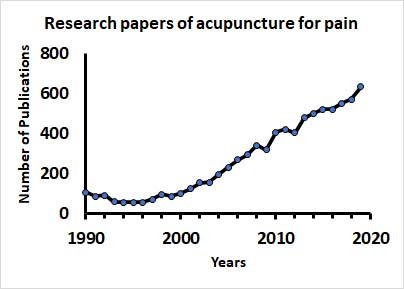
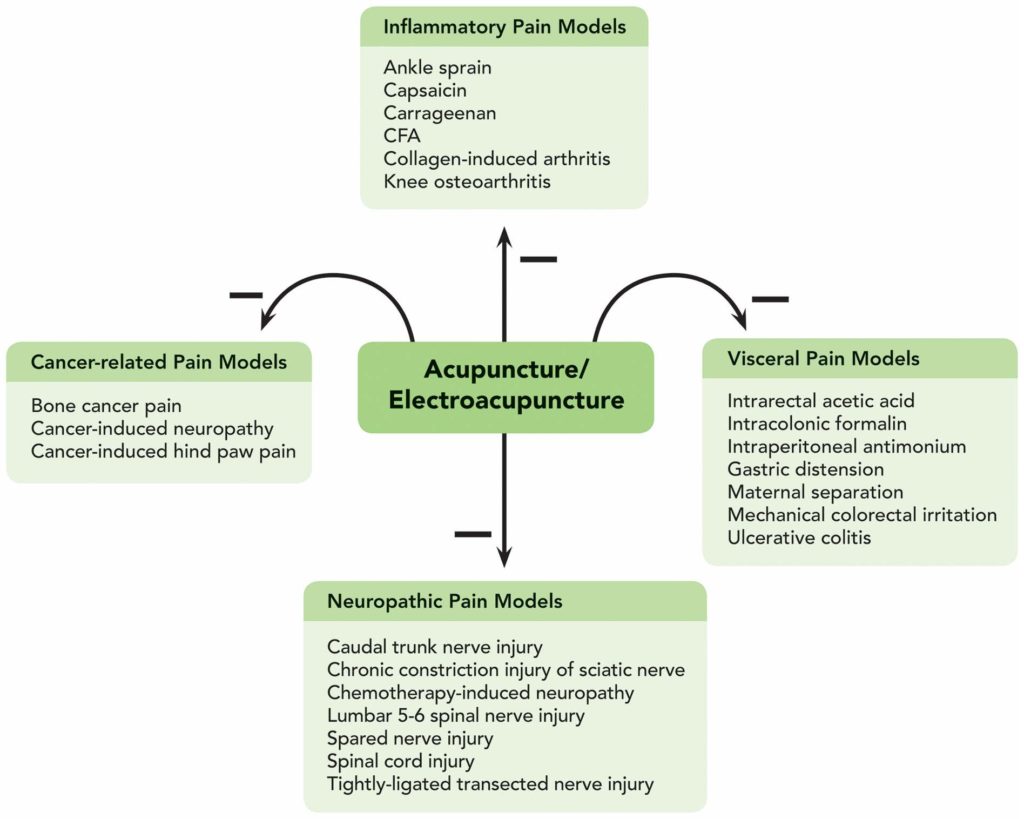
2. Neuronal Reaction
The inserted needles stimulate the local free-nerve endings (receptors), which sent signal to the central nervous system (CNS) through afferent neural pathways. Every level of the CNS responds to the signals, leading to downstream effects—activating a healing process. The crosstalk of the nervous system with the endocrine system and immune system amplify and enhance these effects.
A 2019 literature systematically which reviews 46 studies found that visceral pain behaviors were significantly alleviated in response to acupuncture treatment in groups compared to in sham acupuncture or no-treatment groups. Acupuncture reduced visceral pain behavior and induced significant changes in neuronal activity as well as in the levels of pain/inflammation-related cytokines and neurotransmitters in the brain-gut axis, including endorphin, epinephrine, cortisol, and prostaglandin E2 in plasma, the levels of c-Fos, substance P, corticotropin-releasing hormone, P2X3, acetylcholinesterase (AchE), N-methyl-D-aspartate (NMDA) receptors, and serotonin in the gut/spinal cord.
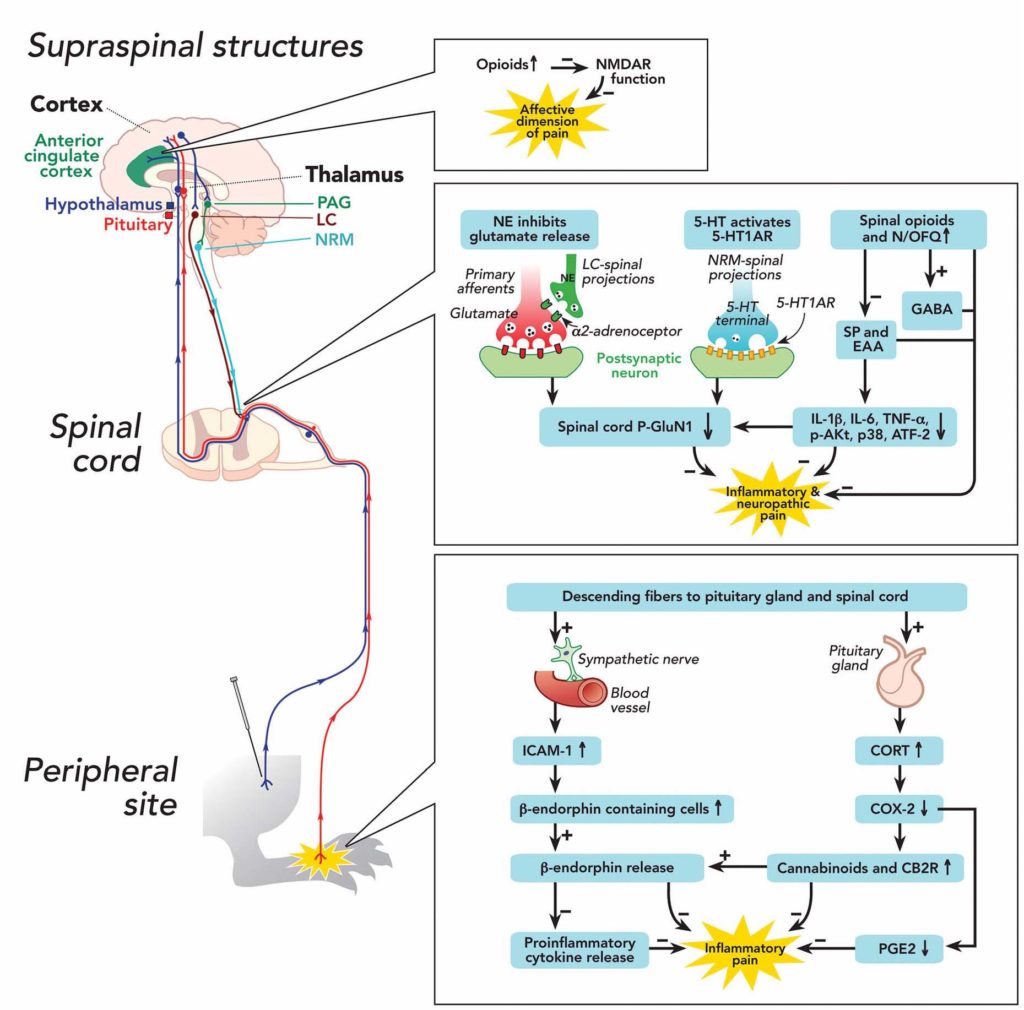
3. Biophysical Reactions
Acupuncture needling is a mechanical stimulation to local connective tissue in additional to the stimulation of never receptors. Helene Langevin reported torque developing during acupuncture needle grasp (Figure 1) .Rotating of acupuncture needles windings connective tissue around the acupuncture needle and pulls collagen fibers and matrix deformation. Muscle cross sections showed histological changes while needle was rotated (Figure 2D), compared with the chance while needle was not rotated (Figure 2C). The mechanical signals were transduced into fibroblasts and/or other cells attached to collagen fibers at focal adhesions. The cellular response is to active local healing process by autocrine and paracrine cellular effects.


4. Biochemical Reactions
Acupuncture also produces a series of biochemical reactions. Although tissue injury by acupuncture is minimal and self-heal, the injury enough initiates a healing process. Researches have shown that acupuncture greatly increases the concentration of many neural and nonneuronal bioactive factors, such as noradrenaline, beta-endorphin, acetylcholine, and somatostatin. Acupuncture also activates local cells including mast cells, fibroblasts, microphages, lymphocytes, and keratinocytes. All of these cells participate heal process by releasing bioactive factors including neurotransmitters; neuromodulators; hormones; cytokines; and inflammatory factors including substance P, calcium gene related peptide (CGRP), histamine, serotonin (5-hydroxytryptamine), interleukin (IL)-1, IL-4, IL-6, IL-8, tumor necrosis factor, and prostaglandin.
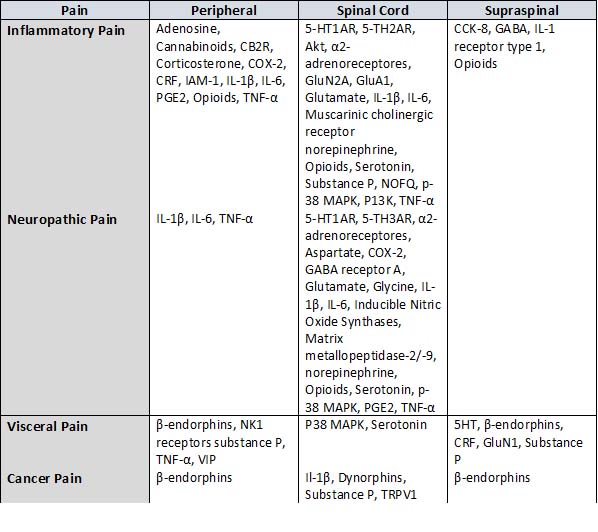
5. Increased Blood Flow
While acupuncture, inserting needle causes a small tissue damage. Injured cells release chemicals, such as substance P, to stimulate Mass cells. Activated Mass cells release histamine to increases capillary blood flow and permeability. Phagocytes and growth factors leave the capillaries and migrated into the location to repair injured tissue (Figure 1). Erythema is observed around needles area during acupuncture treatment (Figure 2), which indicates blood flow on the location is increased. To understand reaction of immune cells around acupuncture needles, we injected the beads, which are similar diameter to acupuncture needle (125-250um), into damaged muscle on mouse. Muscle cross sections showed that T cells, which were identified by antibodies to CD45, migrated into the beads to form a ring around beads(Figure 3). Erythema is considered an early sign of positive therapeutic outcome.
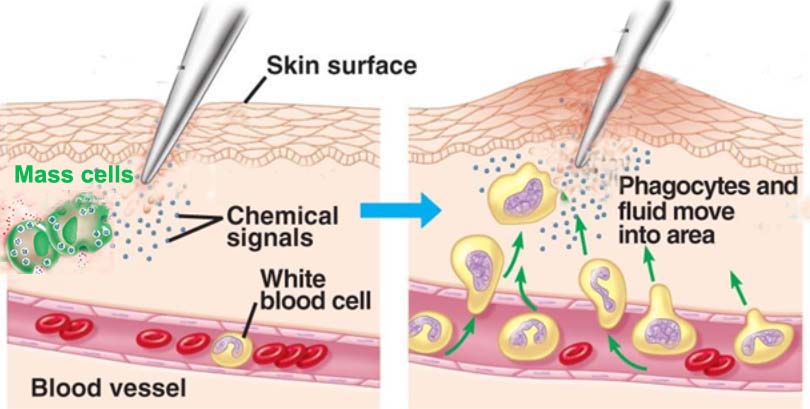
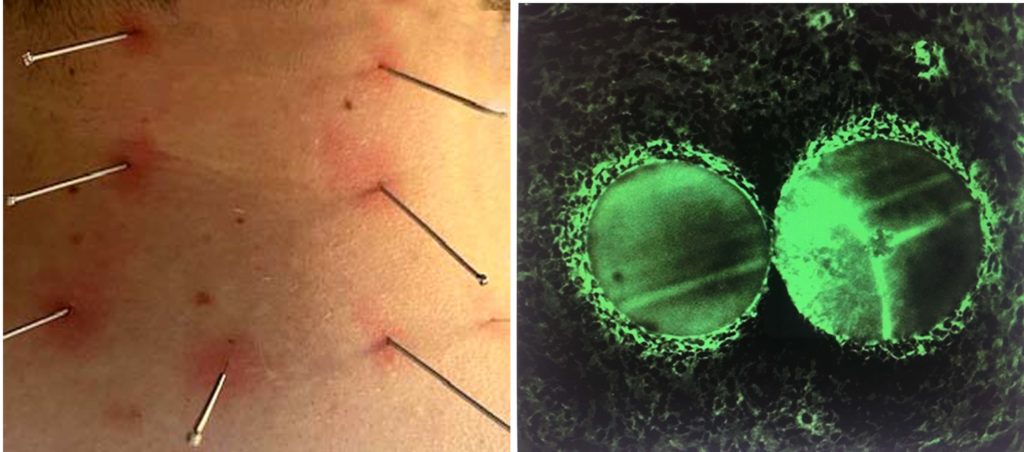
6. References
1. Ruixin Zhang , Lixing Lao, Ke Ren, Brian M Berman,Mechanisms of Acupuncture-Electroacupuncture on Persistent Pain,Anesthesiology, 2014 Feb;120(2):482-503.PubMed
2. Lawrence Leung, Neurophysiological Basis of Acupuncture-Induced Analgesia–An Updated Review,J Acupunct Meridian Stud, 2012 Dec;5(6):261-70.PubMed
3. Andrew J Vickers , Emily A Vertosick , George Lewith , Hugh MacPherson , Nadine E Foster , Karen J Sherman , Dominik Irnich , Claudia M Witt , Klaus Linde , Acupuncture for Chronic Pain: Update of an Individual Patient Data Meta-Analysis, J Pain, 2018 May;19(5):455-474.PubMed
4.Benjamin Kligler , Arya Nielsen, Corinne Kohrherr, Tracy Schmid , Eve Waltermaurer , Elidania Perez , Woodson Merrell , Acupuncture Therapy in a Group Setting for Chronic Pain,Pain Med, 2018 Feb 1;19(2):393-403.PubMed
5. H M Langevin 1, D L Churchill, M J Cipolla,Mechanical Signaling Through Connective Tissue: A Mechanism for the Therapeutic Effect of Acupuncture,FASEB J 2001 Oct;15(12):2275-82.PubMed
6. Wei Zhou, Peyman Benharash Effects and Mechanisms of Acupuncture Based on the Principle of Meridians,J Acupunct Meridian Stud, 2014 Aug;7(4):190-3.PubMed
